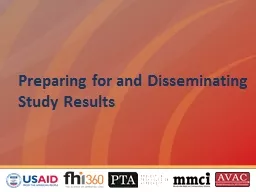

Overview This session will cover how to Develop and implement a dissemination plan Correctly time the release of information and results to various stakeholders Plan for various outcomes Orchestrate the public announcement of results ID: 474983
Download Presentation The PPT/PDF document "Preparing for and Disseminating Study Re..." is the property of its rightful owner. Permission is granted to download and print the materials on this web site for personal, non-commercial use only, and to display it on your personal computer provided you do not modify the materials and that you retain all copyright notices contained in the materials. By downloading content from our website, you accept the terms of this agreement.
Slide1
Preparing for and Disseminating Study ResultsSlide2
Overview
This session will cover how to:
Develop and implement a dissemination plan
Correctly time the release of information and results to various stakeholders
Plan for various outcomes
Orchestrate the public announcement of results
Plan post-dissemination activitiesSlide3
Dissemination
Planning
Carefully planned dissemination of results is increasingly recognized as essential to the research process.
Planning for dissemination should begin months before the results are known.
Advocates, members of community advisory boards (CABs) and trial participants can help shape messages and dissemination strategies.Slide4
Dissemination
Activities Package
Information sharing with participants, CAB and staff members
Formal notification to ethics committees, ministries of health, regulators, government officials and sponsors
Outreach to community leaders and those involved in related trials
Distribution of results summaries to trial stakeholders
Journal publications and presentations at conferencesSlide5
Constructing your Dissemination Plan
Consider your initial communications strategy.
Establish a team and determine how decisions will be made.
Discuss how you will release results and draft a dissemination plan.
Ensure that each site has a tailored plan.
Decide how to inform study participants.Slide6
Considerations for Off-Site Communicators
Involve staff at trial sites early in the process so they can adjust time and work plans accordingly.
If resources allow, provide:
Tailored technical assistance
Materials that can be adapted for local site use
Support to local advocacy groups to adapt materials
Assistance to partners in dissemination planning
Case studiesSlide7
Updating Messages and MaterialsSlide8
Timing is Everything!
Develop a detailed (and flexible) timeline to assist with results dissemination.
Work
backwards from the release date.
Allow time for input between sponsors and networks.
Allow time for adaptation and translation of materials.
Account for staff attrition and close of study budgets.
Monitor journal and conference submission deadlines.Slide9
Releasing Results
Participants should be informed as close to the public announcement as possible.
Confidentiality issues will affect the timing of releases. Honor embargoes.
Consider time zones, Daylight Savings Time (U.S.) or British Summer Time (U.K.), government holidays and international events.
Try to anticipate factors that might affect your announcement strategy.Slide10
Planning for Various Outcomes
Anticipate positive, neutral and negative scenarios, and describe the implications of each.
How will each scenario change your announcement strategy?
Develop key messages and background materials for all possible scenarios.
An internal Q&A is a great tool for messaging.Slide11
Recommendations for Background Materials
Backgrounder that summarizes main findings
Fact sheets targeted to specific audiences
Press release
External Q&A
Flyers, posters and brochures
Letter of thanks to trial participants
Trial newsletterSlide12
Managing Embargoes and Pre-Release
Are confidentiality agreements needed?
Who needs to know what? When? How? Categorize your stakeholders by when they must receive results.
Carefully plan media embargoes and the timing of your press releases.
Learn the embargo policies of prospective conferences and publications.
Always include multiple time zones in press release.Slide13
Orchestrating the Public Announcement
In-country communications firms can tap local networks and contacts.
Close coordination is required to ensure consistent messaging to local opinion leaders and stakeholders.
Use the announcement to celebrate participants, staff, partners and stakeholders.
A local event can help accomplish this goal
.
Monitor media coverage so you can quickly correct any mistakes.Slide14
Approaches to Stakeholder Notification
Certain stakeholders require different treatment.
Policymakers and government: face-to-face meetings are an important form of contact.
Politicians are busy; provide summaries of long materials.
Participants: Community forums, newsletters, thank you
letters or text messages are appropriate for sharing results.
Community members: open meetings
Advocacy networks: conference calls or listserv communicationsSlide15
Giving Trial Participants a Voice
Work with your IRB to develop a policy for allowing participants to engage with the media.
Develop a procedure for selecting potential trial participants spokespeople.
Share with you IRB examples of past successful experiences.
Explain the downside of not involving participants in media interviews.
Journalists may talk to ill-informed or disgruntled participants instead.Slide16
Post-Announcement Dissemination Activities
Depending on results, activities may continue for months after the trial closes.
Media monitoring should continue beyond the trial closure.
Research results should be published in a peer-reviewed scientific journal.Slide17
Promoting the Use of Research Results
Involve key stakeholders in dissemination.
Enlist allies trusted by their peers
Highlight the implications of your findings for practice.
Take advantage of simple ways to increase your reach.
Kenyan Prime Minister Raila Odinga generates interest by attending an
event about male circumcision for HIV prevention
.Slide18
Summary
Your dissemination plan should be guided by lessons learned in implementing your communications plan.
Scenario planning reduces the risk that you will be unprepared to address the implications of study results.
Disseminating study results and their implications for practice helps promote application of the findings.
The time during and after
results dissemination should
be used to expand networks and establish lasting relationships with key contacts in your field and in related disciplines.Slide19
For More Information
publications@fhi360.org